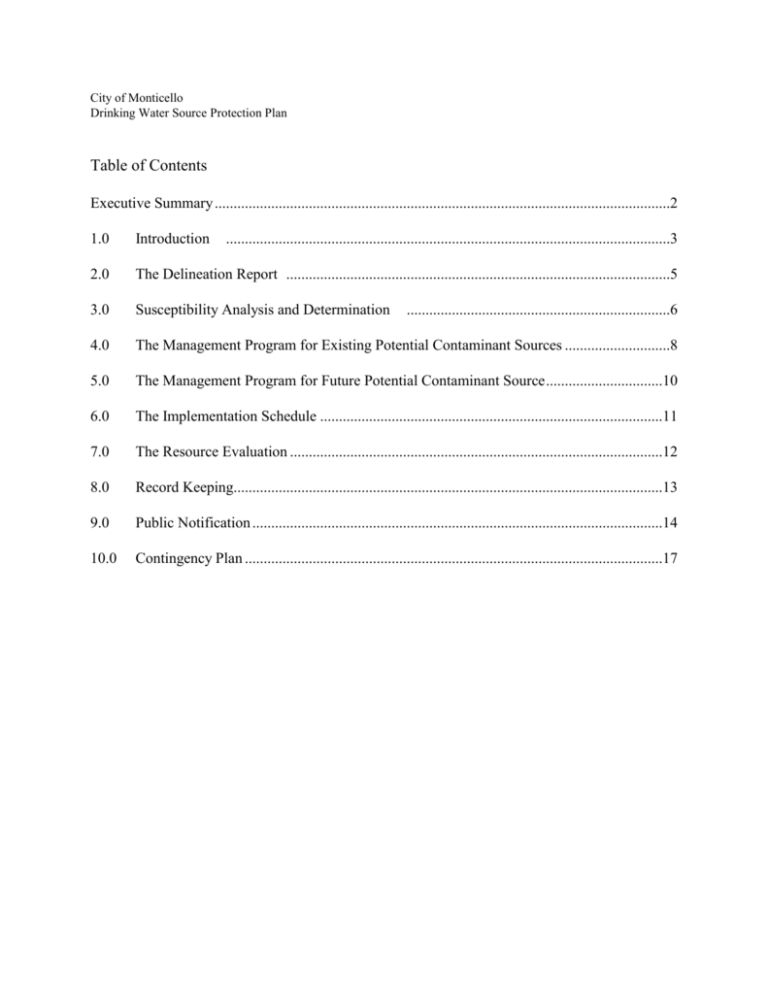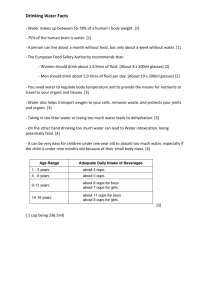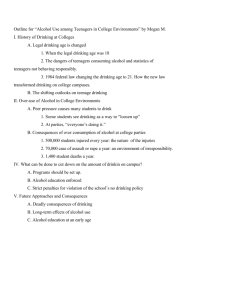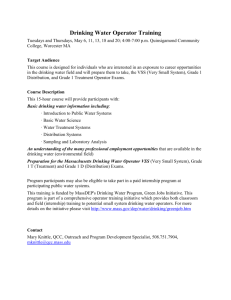City of Monticello Drinking Water Source Protection Plan.pdf
advertisement

City of Monticello Drinking Water Source Protection Plan Table of Contents Executive Summary .........................................................................................................................2 1.0 Introduction ......................................................................................................................3 2.0 The Delineation Report ......................................................................................................5 3.0 Susceptibility Analysis and Determination 4.0 The Management Program for Existing Potential Contaminant Sources ............................8 5.0 The Management Program for Future Potential Contaminant Source ...............................10 6.0 The Implementation Schedule ...........................................................................................11 7.0 The Resource Evaluation ...................................................................................................12 8.0 Record Keeping..................................................................................................................13 9.0 Public Notification .............................................................................................................14 10.0 Contingency Plan ...............................................................................................................17 ......................................................................6 City of Monticello Drinking Water Source Protection Plan Executive Summary This Updated Source Protection Plan was prepared by the Monticello Water Department, for Blue Mountain Springs the public drinking water source for the City of Monticello. This report was completed to assess the raw water quality of its public drinking water source and potential contaminant threats, as required by the 1996 Safe Drinking Water Act and by R309-600 and 605 of the State of Utah Drinking Water regulation 2 City of Monticello Drinking Water Source Protection Plan 1.0 Introduction 1.1 Assessment The City of Monticello has prepared this Source Protection Plan (SPP) for the purpose of protecting the city’s raw water source by identifying and managing potential sources of contamination and threatening activities that occur or may occur in the water shed area. This assessment is for the Blue Mountain Springs watershed which provides water to the City of Monticello. 1.2 System Information The City of Monticello public drinking water system no. 19004 is a community water system. Information on “tap” water quality is available in the City’s Consumer Confidence Report available by contacting the city office. The address is: City of Monticello 17 N 100 E PO Box 457 Monticello UT 84535 (Phone) 435-587-2271 (Fax) 435-587-2272 1.3 Source Information The Blue Mountain Springs water source is made up of 34 springs and surface intakes(Water Right 09-1278 2.1cfs year round) which deliver water to a 125 acre foot reservoir located at N.37* 51' 21.7" W. 109* 22' 22.2" then into a 25 acre foot reservoir before entering the water plant. Both reservoirs are fenced with 6' chain link with barbed wire on top and the banks are elevated and slope away all the way around. Classified by the State of Utah as a surface source, it is the City of Monticello’s sole source of drinking water at this time. For this assessment, Blue Mountain Springs has been divided into five sub sources, North Creek N.37* 51' 47.3" - W. 109* 27' 21.6" ) Bank Head (N.37* 51' 49.7" W.109* 26' 13.9") Pole Canyon (N.37* 51' 25.4" - W. 109* 23' 49.4") Gold Queen ( 3 City of Monticello Drinking Water Source Protection Plan N.37* 49' 29.5" - W 109* 25' 47.5" ) Loyds Lake (N.37* 51' 19.7" - W.109* 21' 34.1"). Loyds is a 3500 acre foot reservoir primarily used for storage, The city owns the first 1000acre feet of lake and Water Right 92-09-01 Shingle Mill Draw And South Creek 194.3 acre feet 4-1to 10-31. The entire system is located on the Blue Mountains and almost all in the Mant-Lasal National Forest Monticello Ranger District, there is a small section in Pole Canyon that is privately owned..Grazing and recreational activities take place within the watershed area. 1.4 Designated Person Nathan Langston Public Works Director City of Monticello 17 N 100 E P.O. Box 457 Monticello UT 84535 Phone- 435-587-2271 Fax- 435-587-2272 4 City of Monticello Drinking Water Source Protection Plan 2.0 The Delineation Report 2.1 The Delineation Report was provided by the Division of Drinking Water (DDW). Refer to Attachment I 5 City of Monticello Drinking Water Source Protection Plan 3.0 Susceptibility Analysis and Determination 3.1 Susceptibility Analysis 3.1.1 Upon recent evaluation of collection system the following has been determined. In 2008 the City of Monticello completed a project in which most of the collection system was replaced. Sixteen new Stream Diversions and 13 Springs Collectors were installed along with isolation valves and blow off valves. This gives the city the ability to isolate poorer quality water if needed. Although the Stream Diversion Structures are still susceptible to contamination the two raw water storage reservoirs in series for settling should allow ample settling of less desirable water during heavy storms and spring run off. The reservoirs are in good repair as is the intake to the plant from the reservoirs. There are valves for isolation of less desirable water. Loyds Lake is pumped to the raw water storage reservoirs to where the other sources enter. Our intake is located in the deepest part of the lake and is screened to prevent large debris from entering our system. Loyds Lake Intake is in good shape. 3.1.2 Further evaluation of the sources contributing to Blue Mountain Springs revealed the following. North Creek area is in a remote location; the terrain is sloped steeply upward on both sides with good vegetation. The soil permeability varies from permeable soils to impermeable rock. There is an abandoned mine in the area (Copper Queen) and a maintained gravel road that runs through the protection zone. Camping and recreation is limited. Bank Head and Pole Canyon are located in an area were the terrain is well vegetated and the ground is not as steep; the soil is mostly permeable. They are both remote and recreation is limited, although there is some grazing. No mines or roads travel through the area. Gold Queen is also in a remote location with the terrain varying in slope, vegetation, and soil permeability. There are two abandoned mines (Danish Girl, Blue Bird) located in the area. Grazing and some recreational activities also take place. Loyds Lake has the 6 City of Monticello Drinking Water Source Protection Plan largest protection zone, with a variety of terrain in the zone. There is also a paved road around the lake which turns into a maintained gravel road. Grazing , camping and other recreation takes place within the protection zone. As a whole Blue Mountain Springs is mostly on forest land. There are no major highways or areas of development , no active mining, or residential areas within the water sheds area. The natural settings and remoteness greatly reduce the likelihood of contamination. Upon review of the Forest Management Plan, it had identified the use requirement needed to maintain water quality. This plan limits grazing, logging, and road construction, it also limits camping and recreational activities and recognizes the effect these activities have on water quality. 3.1.3 After an analysis of the susceptibility and the inventory of the potential contamination sources, it was concluded that all sources are adequately controlled. There are no large point hazardous substances stored, used, made or disposed of within the protection zones. The remote natures of these zones limit the susceptibility to hazardous substances. As mentioned the Forest Management Plan limits activities that contribute to large point and non point sources of contamination. 3.2 Susceptibility Determination Most of the intake structures are highly susceptible to contamination; however, any PCS located within the protection area was concluded to be adequately controlled. 3.3 Prioritized Potential Contamination Source Inventory Currently there are no known Uncontrolled Potential Contamination Sources (PCSs) located with in the protection zones delineated by the DDW. 7 City of Monticello Drinking Water Source Protection Plan 4.0 Management Plan To Control Existing Potential Contamination Sources Currently there are no known Uncontrolled Potential Contaminant Sources located within the area delineated by the DDW. For informational purposes, the following table of Regulations Controlling Pollution has been added to this section of the report. Regulations Controlling Pollution Regulatory Agency Regulation Division of Water Quality R317-6, Utah Administrative Code(UAC) Ground Water Quality Protection Rule-regulates contaminated discharges to ground water. R317-7, UAC Underground Injection Control Rule-Regulates the subsurface emplacement of fluids through bored, drilled, driven or dug wells. R317-8, UAC Utah Pollutant Discharge Elimination System Ruleregulates the discharge of pollutants from point sources into waters of the State. R317-5, UAC Large Underground Wastewater Disposal System Rule-regulates the discharge of wastewater to underground disposal systems. R315-1, UAC Hazardous Waste Rules, Resource Conservation and Recovery (RCRA)- regulates “cradle to grave” management of substances classified as hazardous wastes. R315-301 through R315320, UAC Solid Waste Permitting and Management Rules (Landfills) R311-200 through R311211 Underground Storage Tank Rules - protects ground water resources by preventing and detecting leaks and spills from underground storage tanks. Section 19-6-301 through Section Comprehensive Environmental Response, Compensation, and Liability Act (CERLA commonly Division of Solid & Hazardous Waste Division of Environmental Response & Remediation Description 8 City of Monticello Drinking Water Source Protection Plan Division of Water Rights Division of Oil, Gas and Mining Department of Agriculture U.S. Environmental Protection Agency U.S. Environmental Protection Agencey Public Utilities Commission 19-6-325, Utah Code Annotated called Superfund) - regulates the release of , and remediation of hazardous substances. 40 Code of Federal Regulations (CFR) Part 355 SARA Title III - provides early comprehensive emergency planning for responding to potential releases of toxic chemicals. R655-4, UAC Water Well Rule - regulates the development of underground water. R655-4-12, UAC Abandoned Water Wells - regulates the abandonment of wells. R643, UAC Oil, Gas and Mining; Non-Coal - regulates abandoned mines. R647, UAC Oil, Gas and Mining; regulates reclamation of noncoal. R645, UAC Oil, Gas and Mining, Coal - regulates coal exploration and mining. R649, UAC Oil, Gas and Mining, Oil and Gas - statewide conservation of natural resources. R649-5, UAC Class II Injection Wells - regulates the emplacement of fluids into the ground through wells. R68-7, UAC Pesticide Control Rule - requires that pesticide application be in accordance with label directions. 40 CFR Emergency Planning and Community Right to Know Act (EPCA or SARA Title SARA Title III) regulations of chemicals and activities under RCRA and CERCLA. 40 CFR Federal Insecticide, Fungicide, and Rodenticide Act (FIFRA) - controls the manufacture , label, sales and use of insecticides fungicides, and rodenticides. 40 CFR Toxic Substance Control Act (TSCA) - regulates the use , storage, and disposal of new chemical substances. Pat 49 CFR, 190-199 State adoption of Federal regulation for the design, construction, operation, inspection and reporting of 9 City of Monticello Drinking Water Source Protection Plan pipelines. Local Health Department 5.0 R317-501, UAC Controls the location and construction of sewer, septic tanks, and drain fields of domestic discharges which do not exceed 5,000 gallons per day. Management Plan To Control Future Potential Contamination Sources 5.1 The Forest Service has control over the management of the watersheds. The City of Monticello plans to work closely with this agency to manage Future Potential Contaminant Sources. 5.2 As a minimum future PCSs will be controlled as follows: 1. 2. 3. 4. Each PCS will be contacted as it locates within the protection zones. Each PCS will be added to the inventory. Each PCS will be identified, and any controls will be assessed. Land strategies will be planned and implemented for each PCS assessed as “not adequately controlled.” 10 City of Monticello Drinking Water Source Protection Plan 6.0 Implementation Schedule The City of Monticello will implement this plan immediately upon being notified that DDW concurs with the plan. Since there are no known uncontrolled Potential Contaminant Sources (PCS’s) currently in the protection area; Implementation will consist only of controlling future PCS’s including: being on the look out for and investigating future PCS’s; working closely with the Forest Service; and writing a letter requesting cooperation from them (send as soon as plan is implemented). See Attachment II 11 City of Monticello Drinking Water Source Protection Plan 7.0 Resource Evaluation The Management Plan herein can be performed at negligible cost. Therefore, a resource evaluation is not required at this time. 12 City of Monticello Drinking Water Source Protection Plan 8.0 Record Keeping ( This Section will be reserved for copies of letters, permits, Land Use Agreements, memoranda of understanding, public education memoranda and other things pertaining to this plan.) Since 2004 the only real activities done were update letter to Forest Service and to reconstruct most of the collection system which is described earlier in the plan. 13 City of Monticello Drinking Water Source Protection Plan 9.0 PUBLIC NOTIFICATION 9.1 Refer to attachment III for a copy of the Public Notification letter (Source Water Assessment Public Summary). 9.2 The Public Notification letter will be published in the local news paper, we will also be posting the letter on bulletin boards around the community. 9.3 We plan to disperse the information as soon as we have approval of the Drinking Water Source Protection Plan (DWSP). 14 City of Monticello Drinking Water Source Protection Plan 10.0 The Contingency Plan I. Emergency Response Plan Emergency response may be required for problems ranging from a backflow incident to a major disaster. Regardless of the magnitude of the disaster, the following organizational and procedural outline will assist in dealing with emergencies. A. Organization. 1. Organization of Personnel. a. The Public Works Coordinator will act as Emergency Coordinator. Duties of the Emergency Coordinator include: (1) Coordinating all emergency actions, personnel and equipment within the drinking water system. (2) Coordinating with law enforcement, fire fighting, medical personnel and any other requests for aid, volunteer efforts and mutual assistance. (3) Coordinating the inspection of all drinking water system physical facilities to determine the degree of damage to each facility. 15 City of Monticello Drinking Water Source Protection Plan b. 2. 3. (4) Prioritizing the repair, replacement or abandonment of any system physical facilities. (5) Coordinating, supervising, and scheduling personnel, equipment, and materials to facilitate the repair or replacement of critical drinking water system facilities. The City Manager will act as the Public Relations Coordinator. The Public Relations Coordinator acts as liaison between the drinking water system and the general public in answering questions and addressing concerns. It is essential that the Public Relations Coordinator work very closely with the Emergency Coordinator in order to be able to provide accurate and detailed information. Duties include issuing emergency information bulletins to the public and news releases to the media. Classification of Emergency: The Emergency Coordinator is responsible for accurately assessing the magnitude of the emergency, and communicating this to the Public Relations Coordinator. Emergencies may be classified as follows: a. Normal (Routine) - Public Works employees and equipment presently on duty are capable of handling the situation. b. Emergency - Problems are beyond the immediate capability of the water system to solve. Volunteers may be needed to assist, the public may need to be notified of boil orders, or rationing may be required. c. Disaster - Problems are well beyond the capability of the water system to solve, recovery time will exceed one week, and cost will be great. Outside assistance is required as well as volunteers, and a Declaration of Emergency is also required. Rationing will be very likely imposed as well as alternative drinking water sources sought. Facility Damage Assessments: The Emergency Coordinator will assess the damage to all physical facilities, and assign work priorities. Each facility must be assessed as requiring either repair, replacement, or abandonment. An estimate of the cost and manpower to restore each facility is also required in 16 City of Monticello Drinking Water Source Protection Plan order to aid in prioritizing the work. In addition, the Emergency Coordinator must consider the possible after-effects of the repairs or replacement of the facilities on the integrity of the drinking water system itself after the emergency. As a minimum, assessment of facilities should include the following: 4. B. a. Reservoirs: Check for seepage, leaks, cracks or problems with the reservoir itself. Landslides, embankment slumps, broken inlet-outlet pipes or under drains could effect the stability of the reservoir. Estimate the remaining amount of water in the reservoir. b. Distribution and transmission pipes: Check all air/vacuum relief valves, and check for visible leaks, cracks, breaks, pressure loss in pressure zones, automatic valve failure, (pressure reducing, pressure sustaining, pressure relief, high altitude, solenoid controlled, etc), and all other facilities that would be useful in gauging the integrity of underground piping including fire hydrants. Identify pressure zone valves and isolation valves in order to either supply, divert, or isolate drinking water in the system. Determination of Priorities: The Emergency Coordinator should determine priorities based on these criteria: a. The drinking water system’s unique design. b. Medical/emergency care requirements. c. Drinking water and sanitation needs of the city. d. Fire fighting requirements. e. Amount of good drinking water stored in system reservoirs. f. Methods and availability of transport for supplying stored water where it is most needed. Implementation. 17 City of Monticello Drinking Water Source Protection Plan 1. General. a. Announce the activation of the Emergency plan to volunteers using telephone, radio, or any other means, and direct them to meet at the Coordinator’s house or other appropriate staging area. b. Volunteer fire and search and rescue may be needed to assist in the situation. A list of contacts will be maintained. c. Maintain a written log of message and directives given during the emergency. d. Brief individuals responsible for responding to telephone and other contacts of the proper response to give customers and other concerned callers. Ensure that everyone contacting the agency receives the same information. e. Ensure that radio communication is limited to vital messages only. 2. Emergency medical facilities: Maintain a roster of emergency medical treatment facilities in the area for ease of maintaining drinking water supplies, transporting drinking water from another source, or transporting injured personnel. 3. Emergency assignments: In the event of an emergency or disaster, volunteers will naturally tend to their families first. Be sure that all volunteers know where they are to report , so they can report to work as soon as they are able. 4. Emergency personnel contacts: Maintain a list of contacts within the search and rescue and volunteer fire department list must be updated with the individuals name, address, phone number. Be sure that ALL volunteers working on the drinking water system are to be placed on a duty roster, and appropriately tracked. This will ensure that they are being rotated for rest and food, and that their whereabouts are known should they be needed elsewhere, or should they become injured and require help. 5. Fire fighting/law enforcement agencies: Maintain an updated listing of contacts within the local and neighboring fire fighting and law enforcement 18 City of Monticello Drinking Water Source Protection Plan agencies, including their phone numbers, radio frequencies, and radio call signs. C. Prioritize work/repair needed. 1. 2. D. General a. If the fire department requests the use of culinary water for any reason, take care that fire fighting does not deplete all drinking water resources. b. Isolate areas that will take the longest to restore service, and arrange for emergency water distribution as follows: (1) Establish drinking water distribution points and ration remaining water. (2) Locate bottled water distribution points to serve immediate water needs. (3) Arrange for trucks and water trailers to be supplied by the National Guard. Potential sources of emergency supplies and equipment. a. Develop and maintain a listing of those agencies, private companies or manufacturs within the local area that can provide assistance during an emergency. b. Agree to assist neighboring water utilities in the event that they have an emergency. Dispatching personnel and equipment. 1. Ensure that every affected individual is aware of the drinking water system’s emergency response plan and their part in it. The Emergency Coordinator will assign additional volunteers as needed. Maintain a list of volunteers 19 City of Monticello Drinking Water Source Protection Plan within the drinking water system’s emergency response plan. 2. E. Requests/response for emergency aid. 1. The Governing Body will preauthorize the Emergency Coordinator the authority to carry out all of the duties stated herein. 2. The Emergency Coordinator should have available at all times an up-to-date listing of commercial suppliers within the local area. A listing of neighboring drinking water systems and government agencies and contact people with them will be kept with the Emergency Response Plan. This list should include the types of specialized equipment, vehicles and trained crews that would be available if needed during an emergency. A bilateral agreement of Emergency Aid and Mutual Assistance should be negotiated with these systems and agencies. 3. F. Be sure that ALL volunteers working on the drinking water system are to be placed on a duty roster maintained at the operations center, and appropriately tracked. This will ensure that they are being rotated for rest and food, and that their whereabouts are known should they be needed elsewhere, or should they become injured and require help. Public notification/press releases: The release of information to the public and news media must be accurate and issued through the Public Relations Coordinator. Information should consist of the following: 1. Centralized news releases and statements to avoid contradictory or confusing statements. 2. Factual responses (no guesswork, speculation or exaggeration). 3. Notification of any possible contamination of the drinking water and resulting boil orders. 4. Information regarding the availability and location of alternate sources of drinking water. 5. Implementation of drinking water rationing. 20 City of Monticello Drinking Water Source Protection Plan G. II. Recovery checklist: Following notification to the Mayor and the public that the emergency has ended, the Emergency Coordinator should complete the following items prior to returning to business-as-usual: 1. Document all contracts, agreements, and emergency work or materials used during the emergency to ensure proper payments and reimbursements. 2. Conduct a detailed safety inspection of the drinking water system facilities. 3. Coordinate the completion of any emergency repairs and schedule permanent service repairs. 4. Notify key agencies (local and state health departments) of emergency repair status and the scheduled completion of the system repairs. 5. Release repaired facilities and equipment for normal usage. 6. Replace or authorize replacement of materials and supplies used during the emergency. 7. Complete permanent repairs and replacements of the system facilities. Rationing Water rationing may be necessary in the event of drought, seasonal overuse, contamination , or accident. The Governing Body shall be responsible for initiating rationing. III. Water Supply Decontamination Plans: Methods of decontamination will depend on the type of pollutants and severity encountered in the water source. IV. Source Development Plans: The City is continuously looking for new ways of increasing source development. 21 City of Monticello Drinking Water Source Protection Plan 22 City of Monticello Drinking Water Source Protection Plan 23







